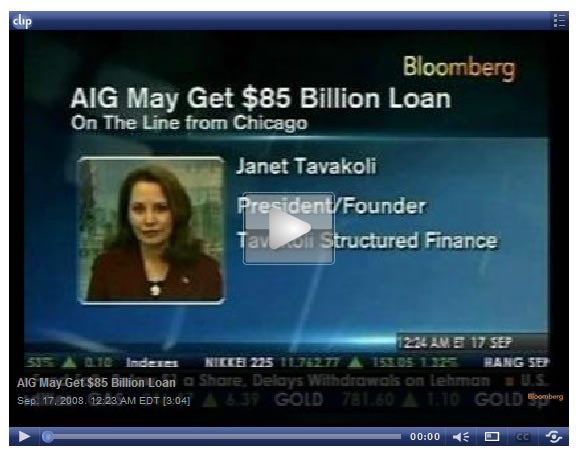AIG Myth: No Time to Avoid Windfall Bailout
Politics / Credit Crisis Bailouts Sep 17, 2013 - 07:48 AM GMTBy: Janet_Tavakoli
 On August 13, 2007, more than a year before the AIG meltdown, I publicly challenged AIG’s phony accounting for credit default swaps linked to over $19 billion in “super senior” exposure to subprime and other dodgy loans. These were meant to be super safe, but any competent CDO specialist should have been able to perform the same analysis I did. Instead of super safe, AIG had several billion dollars worth of principal risk due to exposure to mezzanine tranches backed by a significant percentage of poorly underwritten loans, and losses were eating through all of the so-called protection. Yet, despite market prices already eroding on the underlying collateral, AIG took no accounting losses at all. That was far from AIG’s only problem.
On August 13, 2007, more than a year before the AIG meltdown, I publicly challenged AIG’s phony accounting for credit default swaps linked to over $19 billion in “super senior” exposure to subprime and other dodgy loans. These were meant to be super safe, but any competent CDO specialist should have been able to perform the same analysis I did. Instead of super safe, AIG had several billion dollars worth of principal risk due to exposure to mezzanine tranches backed by a significant percentage of poorly underwritten loans, and losses were eating through all of the so-called protection. Yet, despite market prices already eroding on the underlying collateral, AIG took no accounting losses at all. That was far from AIG’s only problem.
“AIG Seeks Small Subprime Risk; Others See More” [AIG's Phony Accounting], by David Reilly, Wall Street Journal Page C1, August 13, 2007.
“Yet the company’s valuation models seem to ignore the fact that those derivatives would likely take a haircut if sold in today’s depressed market. ‘There’s no way these aren’t showing a loss,’ says Janet Tavakoli, president of Tavakoli Structured Finance Inc., a Chicago research firm. ‘That’s simply a market reality, she adds, that should be showing up in AIG’s results.’”
AIG called me with a standard charm offensive after my comments appeared in the WSJ.
In later months, AIG was cited for material accounting weakness. Yet none of AIG’s officers were held accountable for Sarbanes-Oxley violations after making materially misleading public statements and signing off on false SEC filings.
On August 13, 2007, also more than a year before the AIG bailout, I appeared with Eugene Ludwig of Promontory Capital, Steve Forbes, CEO of Forbes, and CNBC’s Carl Quantanilla to discuss AIG’s failure to record accounting losses, hedge funds, and liquidity and insolvency issues. You may be able to view the video if you have access to CNBC Pro. Mary Shapiro, former head of the SEC, entered the revolving door and now works for Promontory. Eugene Ludwig stated the following in response to the ECB’s assertion that credit markets were stabilizing after cash injections.
“I think the Central Banks around the world have the tools to be able to contain this credit correction, and it’s clear they’re prepared to use them. And what we’ve seen right now is they’ve used those tools and it’s calming the marketplace.” Incredibly, Ludwig claimed banks were “less directly involved in the subprime correction” and were “well-regulated” and “disciplined.”
How did that work out for the banks including Citigroup, Bank of America, and JPMorgan Chase in September 2008? Not only was the above statement not true, banks were subject to their unwise interconnections with hedge funds and insurers as well as their own contributions to systemic risk.
I said the following about AIG:
“AIG must believe in miracles, because if they think that we’re going to believe their credit default swap mark-to-markets on their super seniors, when they have CDO-squared risk, and their portfolios are populated with BBB [rated] tranches backed by subprime paper to the tune of 29%…”
Carl Quantanilla interrupted: “whistling past the graveyard.”
Exactly.
Who did the bailout most benefit?
As the TARP report later revealed, Goldman Sachs would have been in trouble in September 2008, and it was the chief beneficiary of the AIG bailout. The bailout was an unjustified windfall for counterparties that were the chief architects of AIG’s distress. Instead of buying AIG’s CDOs at 100 cents on the dollar, each deal should have had a thorough fraud audit and not only should further billions not have been paid, billions already paid out should have been clawed back. Instead of potential indictments, the Fed rewarded this behavior with unconditional bailouts.
Bloomberg TV – September 17, 2008.
By Janet Tavakoli
web site: www.tavakolistructuredfinance.com
Janet Tavakoli is the president of Tavakoli Structured Finance, a Chicago-based firm that provides consulting to financial institutions and institutional investors. Ms. Tavakoli has more than 20 years of experience in senior investment banking positions, trading, structuring and marketing structured financial products. She is a former adjunct associate professor of derivatives at the University of Chicago's Graduate School of Business. Author of: Credit Derivatives & Synthetic Structures (1998, 2001), Collateralized Debt Obligations & Structured Finance (2003), Structured Finance & Collateralized Debt Obligations (John Wiley & Sons, September 2008). Tavakoli’s book on the causes of the global financial meltdown and how to fix it is: Dear Mr. Buffett: What an Investor Learns 1,269 Miles from Wall Street (Wiley, 2009).
© 2012 Copyright Janet Tavakoli- All Rights Reserved Disclaimer: The above is a matter of opinion provided for general information purposes only and is not intended as investment advice. Information and analysis above are derived from sources and utilising methods believed to be reliable, but we cannot accept responsibility for any losses you may incur as a result of this analysis. Individuals should consult with their personal financial advisors.
© 2005-2022 http://www.MarketOracle.co.uk - The Market Oracle is a FREE Daily Financial Markets Analysis & Forecasting online publication.




